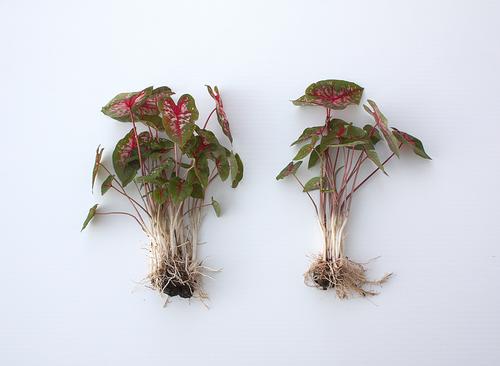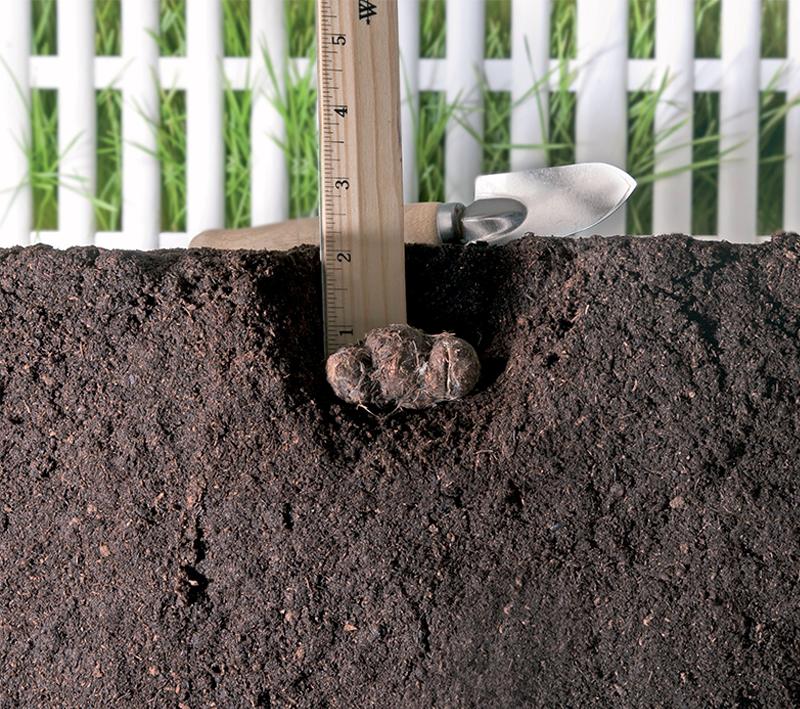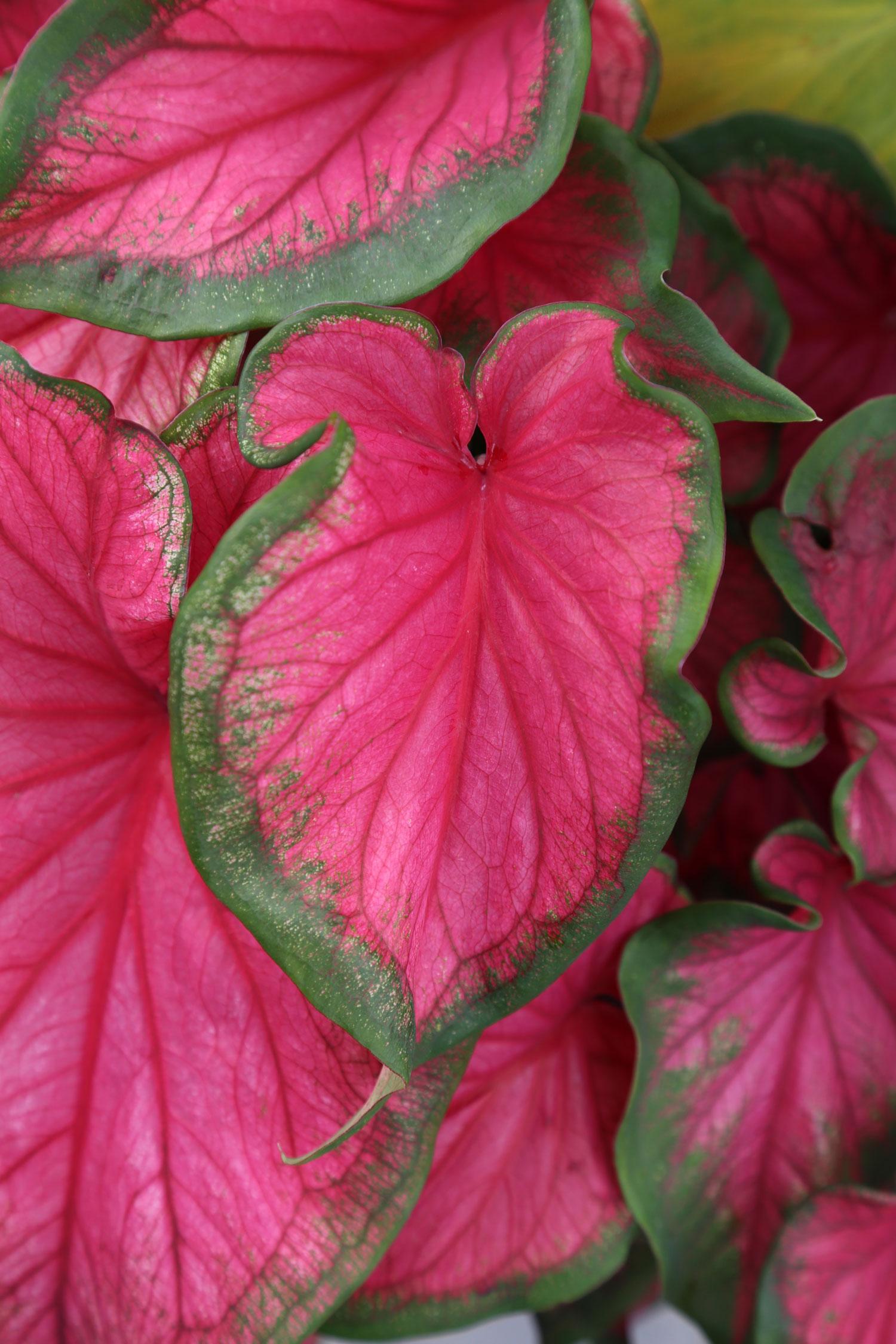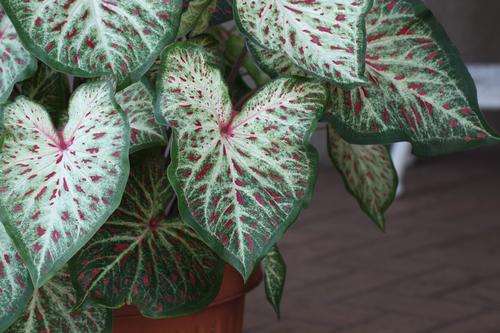Your Guide to Planning, Planting, and Growing Caladiums
Caladiums are tropical plants known for their big, heart-shaped leaves that display amazing color combinations of white, pink, red and green. Though caladiums rarely flower, their foliage guarantees a colorful show wherever they are planted -- beneath trees, between shrubs, in perennial borders or in containers.
Start with a Better Bulb
It’s easy to see a difference in quality when you compare two caladium plants side by side. Caladium tubers are graded by size. The largest ones are graded #1 and measure 1.5 to 2.5” in diameter. Smaller tubers are graded #2 or #3. Longfield Gardens offers only grade #1 caladium tubers. These larger tubers (as shown on the left) have more growth points, or "eyes," and grow into larger and fuller plants.

Plan for Success
Shade and Sun: Caladiums are excellent plants for shady yards and gardens, yet most varieties are surprisingly sun tolerant. Sun tolerance varies from one variety to another, and is also affected by the intensity of the sun and the amount of moisture the plants receive.
Zone: Caladiums are tropical plants and will not survive the winter outdoors unless you garden in zones 9-11. In these warm climates, the tubers may be left in the ground all year round. In zones 3-8, caladiums are usually grown as annuals, planted outdoors in late spring once the soil is warm. Not sure about your hardiness zone? Check out our zone map here.
When to Plant: Caladiums need warm soil and warm overnight temperatures in order to begin growing. If the tubers are planted into cold soil, they will not sprout and may rot. Do not plant the tubers outdoors until nights are warm and the soil temperature is at least 65ºF. In cooler climates you can give your caladiums a head start by sprouting the tubers indoors 4-6 weeks before planting time. Plant the tubers shallowly in pots or seedling flats. Keep them warm (70°F) and barely moist to encourage sprouting.

How to Plant Caladiums
In northern and central areas, caladium tubers should be planted about 6" apart on center. This will give you a nice, full look. In southern areas they can be planted further apart. When growing caladiums in containers, you may want to put the corms closer together.
Caladium tubers may be planted in individual holes or you can dig out a larger area and plant a few tubers at once.
Plant tubers smooth side down, approximately 3" deep. After planting there should be 1-2" of soil on top of the tuber.
If the soil is moist, there's no need to water after planting.

Where to Plant Caladiums
Containers, Patios and Decks: Decorate your outdoor sitting areas with beautiful foliage. Caladiums grow well in pots and planters, and are the perfect solution for brightening a shady porch or a covered deck.
Window Boxes: Strap leaf caladiums grow beautifully in window boxes and hanging planters. Use them to wrap your home in colorful foliage all summer long.
Entryways and Borders: Use fancy leaf caladiums to soften a walkway to your front door, edge a shady garden bed, or line a path among shade trees and shrubs.
Mailbox Gardens: Surrounding your mailbox with pretty foliage will increase your home's curb appeal and create a charming "mini-garden" for all to admire.
Companion Plants in the Garden: Depending on which varieties you choose, caladiums can be bright and flashy or cool and sophisticated. The pinks, greens and whites pair beautifully with other soft colors, and the red-leaved varieties can hold their own when combined with hot-colored begonias, coleus and impatiens.

Planting Tips
Wait to plant your caladiums outdoors until two or three weeks after the last frost date. Nights should be warm and the soil temperature should be 65-70°F. In cool climates this will be in early to mid-June.
Some caladium varieties are more sun tolerant than others, but most appreciate some shade during the hottest part of the day.
Like most plants, caladiums grow best in fertile, well drained soil. You can improve the texture, fertility and moisture-holding capacity of your soil by incorporating compost or top soil. During the growing season, caladiums need consistent moisture and appreciate an occasional dose of liquid fertilizer.
Large tubers usually have multiple eyes (growth points). Small tubers may have only one dominant eye. To achieve a bushier look, you can plant two small tubers together. Experienced caladium growers sometimes "de-eye" the tubers before planting. This technique involves cutting out the dominant eye to encourage other eyes to develop. It's a bit tricky to master and not required for good results.

Caring for Your Caladium After the Growing Season
Caladiums are tropical plants and they will not survive cold winters. If you live in USDA zones 3-7, it's usually best to treat your caladiums as annuals, and plant fresh bulbs each spring. There is no need to dig the tubers at the end of the growing season as they will disintegrate over the winter.
Though caladiums are not reliably hardy in zone 8, you can try insulating the tubers from cold with a thick layer of mulch. Another option is to bring them indoors for the winter. If you want to dig up the tubers, do it before the soil temperature drops below 55ºF. Leave some foliage attached so it's easier to label which variety is which.
After digging, spread the plants out in an area that's protected from rain, cold and direct sunlight. Allow them to dry for at least a week and then cut the foliage away from the tubers, keeping like varieties together. Place the tubers in mesh bags or pack them loosely in dry peat moss. Store in a cool, dark place where the temperature will not fall below 60ºF. Replant in spring.

Caladium tubers are hardy in zones 8-12 and do not need any special care to survive the winter. As the plants enter dormancy in late summer or early fall, the leaves will droop and eventually wither. Simply leave the tubers in the ground where they are and wait for the plants to re-emerge in spring. As long as the soil is well drained and does not freeze, the tubers will give you another great show next year.
Learn more about caladiums here: Landscaping with Caladiums, How to Grow Summer Bulbs in Containers, Summer Bulbs for Shady Gardens, Tips for Growing Caladiums in Zones 5-7
Shop for caladiums HERE.


